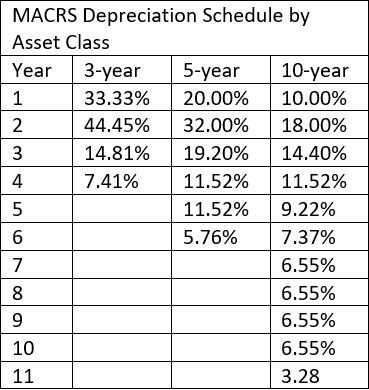What is depreciation and how does it impact my business?
Depreciation is a process of recoding the cost of a major purchase over time. It is a result of the fact that businesses must make large purposes and often pay for those purchases all at once. Because these single purchases are so out of whack with the normal expenses of the business, it does not make sense to put that entire purchase through your financials at the time of purchase. For example, a small business buying a truck would show a pretty bad month if the P&L for that month had to show a $30,000 one-time expense. Depreciating over time spreads out the cost of that expense more in line with actual use of the truck, or piece of equipment or whatever it may be and thereby give the owner a truer picture of their actual profit and loss.
However, it doesn’t take a savvy business owner long to realize that showing a big loss can be helpful in reducing taxable income. They may not care what it looks like as long as it saves on taxes. This is where the government comes in, because, of course, they have a stake in this now as well. The IRS knows the many opportunities for business owners to game the tax system through the timing of these purchases. Therefore, the IRS has rules for how fast you can depreciate an asset.
With all of these factors at play, it is not surprising that accounting for depreciation has become very complicated. Depreciation is one of many examples of how accounting causes changes to the American corporate tax system as the government tries to balance their own depreciation rules against the accountants’ ability to use those rules in favor of paying less tax.
Throughout the 20th century, there was much debate about how depreciation. In 1981, President Reagan and Congress implemented the “10-5-3” plan; this framework sets up a depreciation schedule where most structures depreciate over 10 years, machinery and equipment over 5 years, and vehicles over 3 years, and it is still used as a general rule today.
Depreciation has also been used as a tool by the George W. Bush and Obama administrations to be a short run stimulus tool. The administrations allowed for what they called bonus depreciation which considerably increases the amount of allowable deductions for depreciation and accelerates the period over which an item can be depreciated.
How to Calculate Depreciation
There are multiple methods for calculating depreciation, these include: straight-line, MACRS, hours-of-service and accelerated depreciation.
Straight-line depreciation is the most straightforward. Simply take the cost of the asset and divide it by the years of useful life and you have the annual depreciation for the asset. For instance, if you bought an asset for $100,000 and the expected life of the asset is 10 years with a salvage value of $0, the depreciation would be, $100,000/10, $10,000 annually.
Net value of asset/useful life = annual depreciation
The MACRS depreciation method is based off a standardized depreciation schedule which depreciated assets at set rates for one year longer than the expected useful life. If the same were to be depreciated in this way, year one would have the same depreciation of $10,000. However, year 2 is increased to, 18% x $100,000, $18000 according to this schedule. Using straight line depreciation as a base, you can see from the table that MACRS has accelerated depreciation for the first 4 years, but the next 7 years are at a decreased rate.
Hours-of-service depreciation uses a slightly different approach to valuing an asset and is typically applied to machines or assets whose life is measured in hours of use and not time overall. To do this calculation, take the total cost less the salvage value and divide the answer by the total hours of expected use for the asset. As an example, imagine you purchase a machine for $15,000 that is given an estimated lifespan of 100,000 hours of use. In the first year you use the machine 4000 hours. The accumulated depreciation for that year is, 15000/100000, 15 cents/hour times 4000 hours, equaling $600 of depreciation for the year.
((Cost of Asset – Salvage Value)/Hour of Expected Use) x Hours used in the Year
The accelerated depreciation method of choice is the Double Declining Balance Method. The idea behind the accelerated method is that the asset lose book value much faster to allow larger tax deductions in the early years of the assets life. This means the asset this is applied to is typically more costly items with longer depreciation schedules.
To calculate the Double Declining balance, take the remaining book value of the asset and multiply it by the percent of straight line depreciation times two.
((cost of asset – salvage value – accumulated depreciation) x ((100%/years of useful life) x 2)
Understanding your Assets
Is there a single depreciation method that is best for your business? Probably not. However, certain methods are easier to manage than others. Straight-line depreciation is by far the easiest method to manage because every year’s depreciation calculation is the same per asset. If you are trying to reinvest in your business quickly you may want to use an accelerated depreciation schedule.
The expected usage of the asset should be a major factor in determining a deprecation schedule for an asset. If usage is expected to be steady throughout the life of the asset, then straight line depreciation is an easy option because the depreciation will go along with usage. If the new asset is going to be measured by machine hours, then the suggested depreciation schedule is hours-of-service. If the asset is one that has a long expected useful life, but its usage is going to be greater in its first few years of service, then an accelerated depreciation schedule should be applied at the owner’s discretion.
